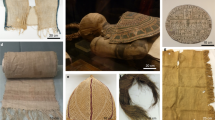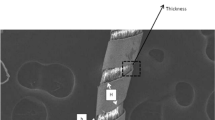Abstract
In this work, it is reported that thermal analysis techniques such as differential thermal analysis and thermogravimetric analysis are very useful for evaluating metals threads and fibres used in the manufacture of historical artifacts. Thermal analysis has been used to characterize the silk, cotton and linen employed as supports and the copper, silver and aluminium as the metallic components in the studied threads. Other organic compounds, mainly added for the conservation of the threads, have also been characterized.











Similar content being viewed by others
References
Braun-Ronsdorf M. Gold and silver fabrics from medieval to modern times. CIBA Rev. 1961;3:2–16.
Jaro M. Gold embroidery and fabrics in Europe, XI–XIV centuries. Gold Bull. 1990;23(2):40–57.
Jaro M, Toth A. Scientific identification of European metal thread manufacturing techniques of the 17–19th centuries. Endeavour, New Series. 1991;15(4):175–84.
Indictor N, Koestler RJ, Wypyski M, Wardwell AE. Metal threads made of proteinaceous substrates examined by scanning electron microscopy-energy dispersive X-ray spectrometry. Stud Conserv. 1989;34(4):171–82.
Theile, J.M., Guarda, S.O.S., Croquevielle, E., Analysis, conservation and restoration of the metal threads used in Latin American colonial Saints’ robes. In: Proceedings of metal. National Museum of Australia Canberra, Australia; 2004. p. 501–13.
Geba M, Lisa G, Ursescu CM, Olaru A, Spiridon I, Leon AL, Stanculescu I. Gamma irradiation of protein-based textiles for historical collections decontamination. J Therm Anal Calorim. 2014;118:977–85.
Tian CM, Shi ZH, Zhang HY, Xu JZ, Shi JR, Guo HZ. Thermal degradation of cotton cellulose. J Therm Anal Calorim. 1999;55(1):93–8.
Bledzki AK. Gassen J (1997) Natural fiber reinforce plastics. In: Cheremisinoff NP, editor. Handbook of engineering polymeric materials. New York: Marcel Dekker Inc.; 1997. p. 810.
Shi R, Tan L, Zong L, Ji Q, Li X, Zhang K, Cheng L, Xia Y. Influence of Na+ and Ca2+ on flame retardancy, thermal degradation, and pyrolysis behaviour of cellulose fibers. Carbohydr Polym. 2017;157:1594–603.
Xu W, Guo W, Li W. Thermal analysis of ultrafine wool powder. J Appl Polym Sci. 2003;87:2372–6.
Seonaid MR. Dyes from plants. New York: Litton Educational Publishing Inc.; 1973. p. 32–4.
Ibrahim SF, El-Amoudy ES, Shady KE. Thermal analysis and characterization of some cellulosic fabrics dyed by a new natural dye and mordanted with different mordants. Int J Chem. 2011;3(2):40–54.
Jaro M, Gal T, Toth A. The characterization and deterioration of modern metallic threads. Stud Conserv. 2000;45(2):95–105.
Ferrero F, Testore F, Malucelli G, Tonin C. Thermal degradation of linen textiles: the effects of ageing and cleaning. J Text Inst. 1998;89(3):562–8.
Calamari TA, Donaldson DJ, Thibodeaux DP. Distinguishing weathered from unweathered cotton by thermal analysis. Am Dyest Report. 1990;79(7):42–7.
Jiang S, Cao G, Cai G, Xu W, Li W, Wang X. Unidirectional torsion properties of single silk fibre. Fibres Text East Eur. 2016;24(3):26–30.
Felix WD, McDowell MA, Eyring H. The differential thermal analysis of natural and modified wool and mohair. Text Res J. 1963;33(6):465–70.
Sadhir RK, Bajaj P, Singh VP. Effect of oxidizing and reducing agents on indian wools: part III-thermal behaviour. Indian J Fibre Text Res. 1980;5:53–6.
Hatakeyama T, Lui Z. Handbook of thermal analysis. Hoboken: Wiley; 1998. p. 470.
Espejo T, Duran A, Lopez-Montes A, Blanc R. Microscopic and spectroscopic techniques for the study of paper supports and textile used in the binding of hispano-arabic manuscripts from Al-Andalus: a transition model in the 15th century. J Cult Herit. 2010;11:50–8.
Acknowledgements
The samples were provided by two embroiderers, Fernando Enríquez Morán [http://brenesenlamemoria.blogspot.com.es/2014/10/bordados-fernandez-y-enriquez_5.html] and Eva Díaz Melero, and by Juan Antonio Conde and Antonio Albardonedo (private collections). Samples were collected to aid in the restoration processes of the artwork. The financial support of the Spanish Commission Interministerial of “Economia y Competitividad” (Plan Estatal 2013–2016 Retos–Proyectos I+D+i) under Project BIA2014-55318-R is also acknowledged.
Author information
Authors and Affiliations
Corresponding author
Rights and permissions
About this article
Cite this article
Perez-Rodriguez, J.L., Perez-Maqueda, R., Franquelo, M.L. et al. Study of the thermal decomposition of historical metal threads. J Therm Anal Calorim 134, 15–22 (2018). https://doi.org/10.1007/s10973-017-6924-x
Received:
Accepted:
Published:
Issue Date:
DOI: https://doi.org/10.1007/s10973-017-6924-x




